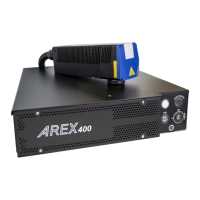Eyes and skin risks
User Manual 99
Accidental vision of the reflected laser radiation
Assuming a direct exposure of 10 seconds at a nominal distance of 0.5 m (worst
case considered), with the Arex™ 400 model using F-Theta scan lens 160 mm, it
is possible to calculate the suitable optical density (O.D.) for safety goggles.
The O.D. (Optical Density) in last column assures the reduction of laser radiation
below max
acceptable exposure.
O.D.= log (H/E
MP) where EMP is the Maximum Permissible Exposure and H is the
radiant exposure.
Arex™ 110-XXX 18.8 m > 4.74
Arex™ 120-XXX 26.5 m > 4.04
Arex™ 130-X6X 31.6 m
> 4.19
Arex™ 150-X6X 40.8 m > 4.41
Arex™ A20-X6X 52.5 m > 4.51
Filter scale index of the protection goggles
The scale index L of the filters indicates the stability against radiation, which
means the ability of the filter to maintain its characteristics unchanged.
This stability is certified by goggles producer according to the UNI EN 207.
It is then necessary to verify that the scale
index of the adopted filter is stable for
this period and to consider an adequate overrating in order to make sure that it
could last longer than the accidental exposure period.
In case of exposure at 0.5 m for 10 seconds,
the suggested optical density for
safety goggles is CLASS L4.
Eyes and skin risks
If exposed to intense Laser radiation, even of a short duration, or a less intense
but longer lasting duration, both the Cornea and the Retina can burn and be
damaged irreparably. This is particularly critical for Class 4 laser beam.
If subject to direct focalized radi
ation, even the skin can burn.
General safety regulations
The user of the laser marker must comply with all regulations and work best
practices regarding safety. Therefore it is necessary to develop a Standard Oper-
ating Procedure (S.O.P.) related to operations of the machine incorporating this
l
aser marker. This procedure, shall be available at time of installation, shall serve
as a reference for the Operator and shall be written in his/her language.
Training is essential and must include:
• Familiarization with system operating procedures.
• Knowledge of the biological effects of radiation on the Eyes and Skin.
• Understanding of the necessity for Indiv
idual Protection Devices (I.P.D.)
SOURCE
N.O.H.D.
(Nominal Ocular Hazard Distance)
O.D.
(Optical Density)

